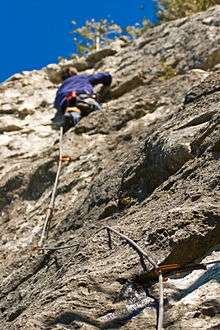Rope drag
In rock climbing, rope drag is the friction of the rope plus its weight that the climber feels when pulling a rope through a number of protection points, or over rock prominences. A large number of anchor placements, especially if they form a zig-zag rather than a straight line, can make the rope drag so bad that the climber can hardly move forward.

Let’s assume a situation where the rope runs through several carabiners which are not all aligned. By using the equations of Euler-Eytelwein to describe the dry friction between the rope and the protection points, the rope drag can be calculated.[1] It can be expressed by an effective mass of the rope that the climber has to pull, which is always larger than the rope mass itself. This effective mass depends exponentially on the sum of the angles of the direction changes the climber has made. “Early errors” by not using longer runners to reduce the angles at the first protection points are less severe than “later errors”, which is plausible when considering that the higher friction points are pre-loaded with more weight from the rope itself.
The chances of rope drag occurring can be reduced by using two ropes in parallel instead of just one (so that for each point of protection, the nearer rope can be used), using carabiners with integral pulleys (such as the DMM Revolver), or by using slings to extend protection so that the rope can stay in a straight line. If drag still happens, then the climber may need (if possible) to stop and set up a belay point sooner than expected.
Rope drag on a dynamic climbing rope also effectively reduces the length of rope available for absorbing fall energy (or, in other words, effectively increases the rope's modulus of elasticity), resulting in higher fall impacts than would be expected using a simple fall factor calculation.
See also
References
- Ulrich Leuthäusser (2011):"Physics of climbing ropes: impact forces, fall factors and rope drag" (PDF). Retrieved 2011-01-15.Retrieved January 16, 2011